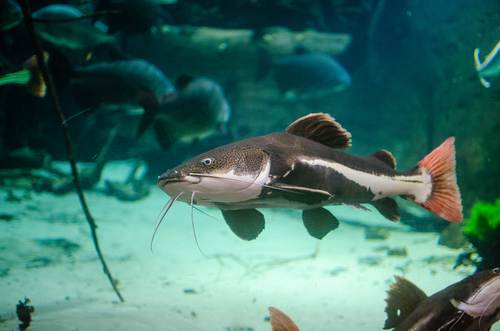
Redtail Catfish
The Atlantic bluefin tuna (Thunnus thynnus) is a majestic and powerful fish, renowned for its size, speed, and migratory prowess. It is a highly sought-after species, prized in culinary circles, but this demand has led to significant conservation concerns.
15 20 years
Lifespan
134 - 180 cm
Length
Least Concern
Conservation Status
Omnivorous, Scavengers
Diet
Local Migration
Migration
Appearance Overview
The Atlantic bluefin tuna is renowned for its large, streamlined body, built for speed and endurance.
Color
Dark metallic blue on top with a silvery underside
Fins
Two dorsal fins, the first depressible; small, yellow finlets run down the back and belly to the tail
Length
up to 13 feet (4 meters)
Weight
up to 2,000 lbs (907 kg)
Diet
Carnivorous, feeding on a variety of fish, squid, crustaceans, and eels
Feeding Behavior
Highly active predator that uses speed and sharp vision to hunt, often cooperatively with other tuna
Social Behavior
Forms large schools, especially during migration and spawning; exhibits complex social behaviors
Commercial Relevance
Extremely high value, especially in sushi and sashimi markets, leading to significant economic impact
Conservation measures
International fishing quotas, catch limits, and monitoring programs; efforts to reduce bycatch
Status
Endangered (Varies by population segment)
Threats
Overfishing, illegal fishing, habitat degradation, and climate change impacts on prey distribution
Habitat Distribution
Depth Range
0-1,000 meters (typically in surface to mid-waters)
Geographic Range
North Atlantic Ocean, Mediterranean Sea, and the Gulf of Mexico
Preferred Environment
Temperate and subtropical waters, open ocean, and coastal areas
Reproduction and Life Cycle
Breeding Habits
Spawns in warm waters, primarily in the Mediterranean Sea and the Gulf of Mexico; spawning is highly synchronized
Development Stages
Eggs hatch into larvae, which develop rapidly; juveniles grow quickly, reaching considerable size within a few years
Fecundity
Females can produce up to 30 million eggs per spawning season
Maturity Age
Matures at 4-8 years (varies by location)
Faqs about Redtail Catfish
How long do Atlantic bluefin tuna live?
Bluefin tuna can live up to 40 years, though this is becoming increasingly rare due to fishing pressure.
Where can I find Atlantic bluefin tuna?
They are found in the Atlantic Ocean, from the Mediterranean Sea to the Gulf of Mexico and the coast of North America.
Can you eat Atlantic bluefin tuna?
Yes, but due to their endangered status, consumption should be avoided to support conservation efforts.
Why are bluefin tuna important?
Bluefin tuna are apex predators, playing a critical role in maintaining the balance of marine ecosystems.
How fast can bluefin tuna swim?
Their streamlined body, powerful muscles, and specialized fins allow them to reach speeds up to 43 mph (70 km/h).
Copyright @ Nature Style Limited. All Rights Reserved.
 English
English